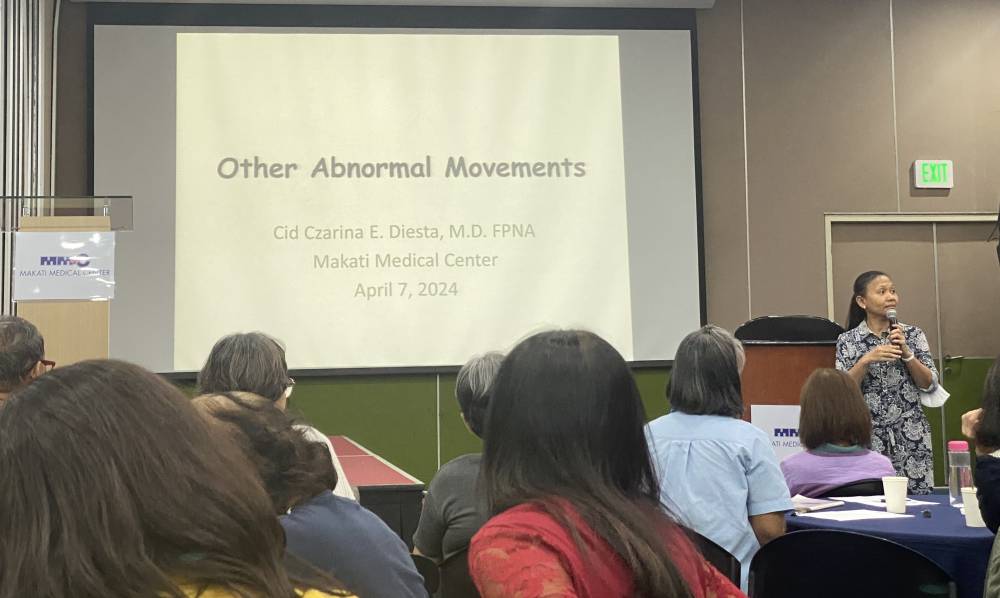Navigating the complexities of Parkinson’s disease

Parkinson’s disease (PD) is the fastest-growing neurological disease globally, and it still has no cure. Having been recently diagnosed with young-onset Parkinson’s disease (YOPD), I attended a symposium on Parkinson’s disease and other movement disorders held at the Makati Medical Center (MakatiMed) last April 7.
The country’s first movement disorders fellow, Dr. Paulo Cataniag, and fellow of the Philippine Neurological Association (FPNA), gave an overview of PD. He opened with a brief introduction of James Parkinson, who first recognized PD as a unique clinical entity in 1817. As he was born on April 11, 1755, his birthday has been established as World Parkinson’s Day, with the whole month of April as Parkinson’s Awareness Month.
Dr. Cataniag talked about late-onset PD (LOPD), diagnosed sporadically in patients over 60 years old. They present with PIGD (postural instability, gait disorder), have a poor prognosis with rapid progression, bradykinesia (slowness of movement), rigidity (muscles are painfully stiff and tighten uncontrollably), depression and anosmia (loss of smell).
YOPD appears in patients below 50 years old, is usually genetic in origin and presents with dystonia (involuntary muscle contraction). YOPD patients are normally tremor-dominant, have a good prognosis with slow progression, and respond well to levodopa medication.

Lifestyle factors
He explained other motor symptoms of PD like hypomimia (reduced facial expression), micrographia (cramped handwriting), shuffling gait, freezing and difficulty rising from sitting or turning in bed, as well as more nonmotor symptoms such as behavioral, cognitive, sensory, dysautonomia (things you do without needing to think about it) and sleep disorders.
Dr. Cataniag also shared lifestyle factors that increase PD risks, like dairy consumption, environmental toxin exposure, pesticide use, exposure to metals and head trauma. Meanwhile, diets high in vegetables, fruits, grains, coffee and tea, anti-inflammatory drug use, physical activity and exercise, using protection when handling pesticides and cigarette smoking were linked to decreased PD risk. He was quick to discourage tobacco use, though, despite this finding, as one would die of cancer or heart disease instead.
Dr. Jed Noel Ong, also a FPNA, spoke about dystonia, which is the second most common movement disorder in the Philippines. These sustained or intermittent muscle contractions cause abnormal, often repetitive movements, postures or both. Dystonic movements are typically patterned, twisting and may be tremulous. It is often initiated or worsened by voluntary action and associated with overflow muscle activation (Albanese, 2013).

From Panay Island
Of particular interest was Dr. Ong’s discussion on X-Linked Dystonia Parkinsonism (XDP), otherwise known as DYT 3 Dystonia or “Lubag syndrome.” It is a progressive neurodegenerative disease affecting mainly Filipino males whose ancestries originate from Panay Island. It typically appears at 39-40 years old and lasts about 16 years (mean age of death is 55 years). Many patients commit suicide as they are ostracized by society. While it is rare for women to show symptoms, they are carriers of the gene. Dr. Ong postulated that the aswang folklore may have stemmed from the unusual appearance and thrashing of such patients from Aklan, Antique, Capiz and Iloilo.
Dr. Jean Quint Oropilla, fellow of the Academy of Filipino Neurosurgeons (FAFN), discussed surgical procedures such as deep brain stimulation (DBS) and ablation. These options may be considered by PD patients who may be further along their PD journey and already resistant to medication.
DBS involves implanting electrodes in the brain to stimulate it. A pacemaker-like device for the brain is placed under the chest, and a wire connects it to the electrodes in the brain. It is more expensive but longer-lasting in effect than ablation, which is the destruction or removal of specific parts of the brain. Ablation can be done through surgery, hormones, drugs, radiofrequency or heat.
Lastly, Dr. Cid Czarina Diesta, FPNA, talked about other movement disorders like ataxia, cervical dystonia, chorea, functional movement disorder, Huntington’s disease, restless legs syndrome, tardive dyskinesia, Tourette syndrome, tremors and Wilson disease. —CONTRIBUTED

















